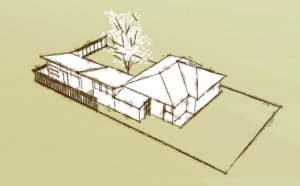
California’s ADU law establishes statewide standards for local regulations governing accessory dwelling unit development. These standards have paved the way for a steady increase in ADU development throughout the state, as homeowners take advantage of the opportunity to legalize pre-existing second units and add additional units. Unfortunately, state law still allows local governments to enact ordinances that render ADU development impossible or prohibitively expensive. Some jurisdictions have local regulations with extreme requirements for minimum lot size, setbacks, floor area, open space, or other requirements that effectively make ADUs illegal on most lots. Other jurisdictions have an approval process that homeowners find impossible to navigate. Other cities use their high impact fees to make ADU development economically infeasible. Yes, of course, some places are going above and beyond the state requirements to encourage ADU development; but others are lagging far behind.
Today, the state legislature passed three bills that together would remove most of these remaining barriers to ADU development. Thanks to the efforts of Assemblymembers Ting, Friedman, and Bloom, Senator Wieckowski, California YIMBY, the Casita Coalition and the 3Ps Coalition, this package of legislation will establish California as a leader in ADU policy nationwide. The following bills have been approved by both houses of the state legislature, and now only require the governor’s signature to be enacted.
Assembly Bill 68 and 881
AB 68 and 881, introduced by Assemblymembers Ting, and Bloom, have significant overlap and would reform many of the same aspects of the state ADU law. Because of this overlap, they were consolidated and enacted as one bill. The broad goal behind the two bills is to remove many of the barriers to ADU development that still allowed in local zoning ordinances. These bills would:
- Prohibit minimum lot size requirements, the easiest way for local governments to limit ADU development.
- Cap setback requirements at 4 feet, opening up a vast amounts of space for ADU development in backyards. Rear yard setbacks affecting ADUs of 25 to 30 feet are very common in single-family neighborhoods throughout the state; such generous mandatory yards can be quite pleasant while also not competing with an ADU for space.
- Prohibit the application of lot coverage, floor area ratio, or open space regulations that would prevent an 800 square foot ADU from being developed on the lot. This would guarantee a homeowner’s right to add an ADU on nearly every single family lot in California.
Meet the Kumars
Santosh Kumar and his wife Shilpa wanted to legalize the ADU that came with their house.
CaRLA’s work helped prove the need for AB 68’s reforms.
- Prohibit replacement parking requirements when an existing garage is converted to an ADU. Requiring replacement parking can make it infeasible to develop an ADU on smaller lots, especially if the replacement parking needs to be covered. Many garage conversions come about because the homeowner no longer needs or wants the parking their garage would otherwise provide; encouraging this is common sense in today’s era of climate change where every mole of carbon matters.
- Limit local discretion in establishing minimum and maximum unit size requirements, guaranteeing at least an 850 square foot unit ADU, or 1000 square feet for an ADU with more than one bedroom.
- Shorten the time period for consideration of ADU permit applications to 60 days, through a non-discretionary process.
- Require that cities reconsider their ADU ordinance if the Department of Housing and Community Development finds the ordinance out of compliance with state law.
The revised subsection (e) is perhaps the most significant change of all. This provision provides some minimum guarantees for every lot in the state that allows for residential use, notwithstanding any requirements of the local zoning ordinance. First, each lot with a proposed or existing single-family home must be allowed to develop a new detached ADU of up to 800 square feet. Alternatively, each single family lot is allowed one ADU and one Junior ADU if each is contained within the space of existing structures. Homeowners also have the option of combining these options by adding a junior ADU from existing space while also adding a new detached ADU to the lot. Lastly, lots with multifamily buildings are allowed to convert unused space to new ADUs, and develop two additional ADUs in new detached structures on the same lot. Importantly, all of the ADUs allowed under subsection (e) would need to be approved ministerially, notwithstanding the requirements of the local ordinance. This means that a minimum of three units would be allowed on all single-family lots in California, [efn_note] Getting to three units would require the conversion of existing structures into an ADU and JADU, or the conversion of an existing structure to an JADU combined with the addition of an ADU. Both of these options will guaranteed for all single-family lots as long as 4 foot side and rear setbacks are maintained.
[/efn_note] and all lots with multifamily buildings would be allowed at least two additional units depending on the amount of unused space.
Senate Bill 13
This bill, authored by Senator Wieckowski, would deal with other major barriers to ADU development that AB 68 and 881 leave unaddressed. SB 13 would mirror some of the provisions of AB 68, such as shortening the time to review ADU permits and prohibiting replacement parking requirements. More significantly, it would also:
- Prohibit owner-occupancy requirements for five years. Current law allows cities to require owner occupancy of either the ADU or single family home on lots that have both, although it is unclear how such a requirement would be enforced. Cities enacting this requirement often do so as an attempt to curb ‘speculation,’ although it is unclear how the requirement would accomplish this goal. The requirement reduces flexibility for homeowners and places a permanent restriction on the property that could affect resale value. Overall, these requirements seem completely unjustified based on the stated rational and that they actively discriminate against renter-occupants.
- Significantly reduce impact fees on ADUs. In many jurisdictions, high per-unit fees can make ADU development financially infeasible for homeowners. These fees can run as high as $35,000 per unit, which would be a huge portion of a family’s construction budget. Under SB 13, impact fees would be eliminated for ADUs under 750 square feet, and would be required to be proportional to the size of the primary dwelling.
- Provide a program for homeowners to delay compliance with certain building code requirements that do not relate to health and safety. This would legalize many already existing ADUs that cannot be brought up to 100% code compliance, establishing a statewide amnesty program for unpermitted ADUs.
Assembly Bill 670
Assemblymember Friedman sponsored this bill, signed into law by Governor Newsom last week, to prevent homeowners’ associations from barring ADUs. Many single family neighborhoods in California were constructed as common-interest developments which often come with a set of property restrictions put in place when the property was originally subdivided and developed. These restrictions, enforced by the local homeowners associations, often limit each lot to a single unit of housing, prohibiting ADU development. This bill would make such restrictions unenforceable and allow for ADU development in these areas if they were found to be unreasonable. [efn_note]Restrictions that “effectively prohibit the construction of” ADUs would be considered unreasonable.[/efn_note]
What does this all mean?
Assuming that the Governor signs all of these bills, ADU development will become much less costly and more available to all homeowners in California. Homeowners seeking to develop ADUs will have two options. First, they will be able to take advantage of paragraph (e) in the new state law and develop one ADU and one JADU with a few restrictions:
- A new detached ADU does not exceed 16 feet in height or 800 square feet in floor area, and maintains 4 foot side and rear setbacks.
- The JADU is converted from an existing structure.
- If the ADU is converted from an existing structure, it is limited to the size of that structure plus 150 square feet.
- The ADU or JADU can only be rented for terms longer than 30 days.
- Fire sprinklers can only be required if they are required for the single-family home.
Importantly, these are the only zoning standards that may be applied for ADUs and JADUs permitted through this process, so homeowners can avoid some difficult requirements still allowed for in local ADU ordinances, like architectural review.
Alternatively, homeowners can choose to apply for ADU permit under the local ordinance, subject to the restrictions outlined above. These local ordinances will be much more permissive than current ordinances due to the changes made by AB 68 and AB 881. The rules may also allow for ADUs that are larger or in a better configuration on the lot than is allowed under the state law process in paragraph (e). Regardless of the path to approval, the fees on ADUs will be drastically reduced thanks to Senator Wieckowski’s SB 13.
The bottom line in all of these changes is that single-family exclusive zoning will be effectively abolished statewide. Most single family lots will be able to fit a duplex, in the form of a single-family home and an 800 square foot ADU or larger. Many lots will also be able to accommodate three units in the form of a single-family home, ADU and JADU. Given the prevalence of single family zoning in California, these changes will represent a massive increase in the state’s capacity for housing development with a stroke of the Governor’s pen.
What’s next?
Some big challenges still remain before we realize the promise of ADU development in California. Even with favorable zoning rules, we need to make it easier for homeowners to step up and commit to developing ADUs. In order for this to happen, we need to be able to offer financing, assistance with the permitting process and affordable ADU builders. Fortunately, there are many California businesses statewide starting up to provide these services for homeowners.
We will also need to monitor local governments to ensure that these changes are implemented by local city councils and planning departments. As part of the Casita Coalition, CaRLA will be reviewing local ordinances as they are proposed and considered throughout the state over the next few months. We’re a small non-profit and to cover the entire state we depend on regular people like you who have joined our Avocado Watch Network to help us keep tabs on it all. With your help, CaRLA will be watching and ready to challenge cities that choose to ignore state law.

